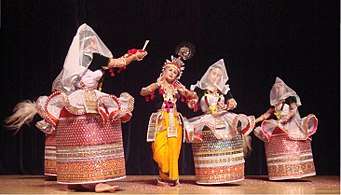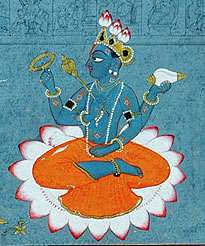Krishna
Krishna (/ˈkrɪʃnə/,[7] Sanskrit pronunciation: [ˈkr̩ʂɳɐ]; Sanskrit: कृष्ण, IAST: Kṛṣṇa) is a major deity in Hinduism. He is worshipped as the eighth avatar of the god Vishnu and also as the supreme God in his own right.[8] He is the god of compassion, tenderness, love[9][10][11] and is one of the most popular and widely revered among Indian divinities.[12] Krishna's birthday is celebrated every year by Hindus on Krishna Janmashtami according to the lunisolar Hindu calendar, which falls in late August or early September of the Gregorian calendar.[13] Krishna is usually depicted with a flute in his hand.
The anecdotes and narratives of Krishna's life are generally titled as Krishna Leela. He is a central character in the Mahabharata, the Bhagavata Purana and the Bhagavad Gita, and is mentioned in many Hindu philosophical, theological, and mythological texts.[14] They portray him in various perspectives: a god-child, a prankster, a model lover, a divine hero, and as the universal supreme being.[15] His iconography reflects these legends, and shows him in different stages of his life, such as an infant eating butter, a young boy playing a flute, a young boy with his lover Radha or surrounded by women devotees, or a friendly charioteer giving counsel to Arjuna.[16]
The synonyms of Krishna have been traced to 1st millennium BCE literature.[17] In some sub-traditions, Krishna is worshipped as Svayam Bhagavan, and this is sometimes referred to as Krishnaism. These sub-traditions arose in the context of the medieval era Bhakti movement.[18] Krishna-related literature has inspired numerous performance arts such as Bharatanatyam, Kathakali, Kuchipudi, Odissi, and Manipuri dance.[19][20] He is a pan-Hindu god, but is particularly revered in some locations such as Vrindavan in Uttar Pradesh, Dwarka and Junagadh in Gujarat; the Jagannatha aspect in Odisha, Mayapur in West Bengal[21] ; in the form of Vithoba in Pandharpur, Maharashtra, Nathdwara in Rajasthan,[22]; Udupi Krishna in Karnataka[23], Parthasarathy in Tamil Nadu and Guruvayoorappan in Guruvayoor in Kerala.[24] Since the 1960s, the worship of Krishna has also spread to the Western world and to Africa, largely due to the work of the International Society for Krishna Consciousness (ISKCON).[25]
Names and epithets
The name "Krishna" originates from the Sanskrit word Kṛṣṇa, which is primarily an adjective meaning "black", "dark", "dark blue" or “the all attractive”.[26] The waning moon is called Krishna Paksha, relating to the adjective meaning "darkening".[26] The name is also interpreted sometimes as "all-attractive".[27]
As a name of Vishnu, Krishna is listed as the 57th name in the Vishnu Sahasranama. Based on his name, Krishna is often depicted in idols as black- or blue-skinned. Krishna is also known by various other names, epithets, and titles that reflect his many associations and attributes. Among the most common names are Mohan "enchanter"; Govinda "chief herdsman",[28] Keev "prankster", and Gopala "Protector of the 'Go'", which means "Soul" or "the cows".[29][30] Some names for Krishna hold regional importance; Jagannatha, found in Puri Hindu temple, is a popular incarnation in Odisha state and nearby regions of eastern India.[31][32][33]
Krishna may also be referred to as Vāsudeva-Krishna, Murlidhar, and Chakradhar. The honorary title "Sri" (also spelled "Shri") is often used before the name of Krishna. The word “Sri/Shri” also means Radha who is said to be the eternal consort and constant companion of Krishna. The Bhagvata purana in the canto number 10 doesn’t mention Radha directly by her name but refer her using different secondary names. This is because Sukadev Goswami who narrated Shrimad Bhagvatam to king Parikshit within 7 days, was a great devotee of goddess Radha and he would have gone into trance for long duration if he himself would have uttered the name “Radha”. A town named “Barsana” in Uttar Pradesh, India is regarded as the birth place of Radharani.
Historical and literary sources
The tradition of Krishna appears to be an amalgamation of several independent deities of ancient India, the earliest to be attested being Vāsudeva.[34] Vāsudeva was a hero-god of the tribe of the Vrishnis, belonging to the Vrishni heroes, whose worship is attested from the 5th-6th century BCE in the writings of Pāṇini, and from the 2nd century BCE in epigraphy with the Heliodorus pillar.[34] At one point in time, it is thought that the tribe of the Vrishnis fused with the tribe of the Yadavas, whose own hero-god was named Krishna.[34] Vāsudeva and Krishna fused to become a single deity, which appears in the Mahabharata, and they start to be identified with Vishnu in the Mahabharata and the Bhagavad Gita.[34] Around the 4th century CE, another tradition, the cult of Gopala-Krishna, the protector of cattle, was also absorbed into the Krishna tradition.[34]
Early epigraphic sources
Depiction in coinage (2nd century BCE)
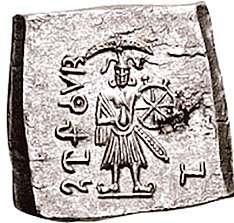
Around 180 BCE the Indo-Greek king Agathocles issued some coinage bearing images of deities that are now interpreted as being related to Vaisnava imagery in India.[38][39] The deities displayed on the coins appear to be Saṃkarṣaṇa-Balarama with attributes consisting of the Gada mace and the plow, and Vāsudeva-Krishna with attributes of the Shankha (conch) and the Sudarshana Chakra wheel.[38][40] According to Bopearachchi, the headdress on top of the deity is actually a misrepresentation of a shaft with a half-moon parasol on top (chattra).[38]
Inscriptions
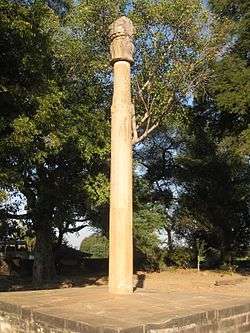
The Heliodorus Pillar, a stone pillar with a Brahmi script inscription was discovered by colonial era archaeologists in Besnagar (Vidisha, central Indian state of Madhya Pradesh). Based on the internal evidence of the inscription, it has been dated to between 125 and 100 BCE, and now known after Heliodorus – an Indo-Greek who served as an ambassador of the Greek king Antialcidas to a regional Indian king Kasiputra Bhagabhadra.[38][41] The Heliodorus pillar inscription is a private religious dedication of Heliodorus to "Vāsudeva", an early deity and another name for Krishna in the Indian tradition. It states that the column was constructed by "the Bhagavata Heliodorus" and that it is a "Garuda pillar" (both are Vishnu-Krishna-related terms). Additionally, the inscription includes a Krishna-related verse from chapter 11.7 of the Mahabharata stating that the path to immortality and heaven is to correctly live a life of three virtues: self-temperance (damah), generosity (cagah or tyaga), and vigilance (apramadah).[41][43][44] The Heliodorus pillar site was fully excavated by archaeologists in the 1960s. The effort revealed the brick foundations of a much larger ancient elliptical temple complex with a sanctum, mandapas, and seven additional pillars.[45][46] The Heliodorus pillar inscriptions and the temple are among the earliest known evidence of Krishna-Vasudeva devotion and Vaishnavism in ancient India.[47][38][48]
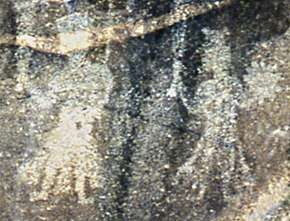
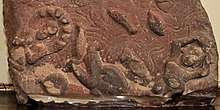
The Heliodorus inscription is not an isolated evidence. The Hathibada Ghosundi Inscriptions, all located in the state of Rajasthan and dated by modern methodology to the 1st century BCE, mention Saṃkarṣaṇa and Vāsudeva, also mention that the structure was built for their worship in association with the supreme deity Narayana. These four inscriptions are notable for being some of the oldest-known Sanskrit inscriptions.[51]
A Mora stone slab found at the Mathura-Vrindavan archaeological site in Uttar Pradesh, held now in the Mathura Museum, has a Brahmi inscription. It is dated to the 1st century CE and mentions the five Vrishni heroes, otherwise known as Saṃkarṣaṇa, Vāsudeva, Pradyumna, Aniruddha, and Samba.[52][53][54]
The inscriptional record for Vāsudeva starts in the 2nd century BCE with the coinage of Agathocles and the Heliodorus pillar, but the name of Krishna appears rather later in epigraphy. At Chilas II archeological site dated to the first half of 1st-century CE in northwest Pakistan, near the Afghanistan border, are engraved two males along with many Buddhist images nearby. The larger of the two males holds a plough and club in his two hands. The artwork also has an inscription with it in Kharosthi script, which has been deciphered by scholars as Rama-Krsna, and interpreted as an ancient depiction of the two brothers Balarama and Krishna.[55][56]
The first known depiction of the life of Krishna himself comes relatively late with a relief found in Mathura, and dated to the 1st-2nd century CE.[50] This fragment seems to be showing Vasudeva, Krishna' father, carrying baby Krishna in a basket across the Yamuna.[50] The relief shows at one end a seven-hooded Naga crossing a river, where a makara crocodile is thrashing around, and at the other end a person seemingly holding a basket over his head.[50]
Literary sources
Mahabharata
The earliest text containing detailed descriptions of Krishna as a personality is the epic Mahabharata, which depicts Krishna as an incarnation of Vishnu.[57] Krishna is central to many of the main stories of the epic. The eighteen chapters of the sixth book (Bhishma Parva) of the epic that constitute the Bhagavad Gita contain the advice of Krishna to Arjuna on the battlefield. The Harivamsa, a later appendix to the Mahabharata contains a detailed version of Krishna's childhood and youth.[58]
.jpg)
The Chandogya Upanishad, estimated to have been composed sometime between the 8th and 6th centuries BCE, has been another source of speculation regarding Krishna in ancient India. The verse (III.xvii.6) mentions Krishna in Krishnaya Devakiputraya as a student of the sage Ghor' of the Angirasa family. Ghora is identified with Neminatha, the twenty-second tirthankara in Jainism, by some scholars.[60] This phrase, which means "To Krishna the son of Devaki", has been mentioned by scholars such as Max Müller[61] as a potential source of fables and Vedic lore about Krishna in the Mahabharata and other ancient literature – only potential, because this verse could have been interpolated into the text,[61] or the Krishna Devakiputra, could be different from the deity Krishna.[62] These doubts are supported by the fact that the much later age Sandilya Bhakti Sutras, a treatise on Krishna,[63] cites later age compilations such as the Narayana Upanishad but never cites this verse of the Chandogya Upanishad. Other scholars disagree that the Krishna mentioned along with Devaki in the ancient Upanishad is unrelated to the later Hindu god of the Bhagavad Gita fame. For example, Archer states that the coincidence of the two names appearing together in the same Upanishad verse cannot be dismissed easily.[64]
Yāska's Nirukta, an etymological dictionary published around the 6th century BCE, contains a reference to the Shyamantaka jewel in the possession of Akrura, a motif from the well-known Puranic story about Krishna.[65] Shatapatha Brahmana and Aitareya-Aranyaka associate Krishna with his Vrishni origins.[66]
In Ashṭādhyāyī, authored by the ancient grammarian Pāṇini (probably belonged to the 5th or 6th century BCE), Vāsudeva and Arjuna, as recipients of worship, are referred to together in the same sutra.[67][68][69]
Other sources
Megasthenes, a Greek ethnographer and an ambassador of Seleucus I to the court of Chandragupta Maurya towards the end of 4th century BCE, made reference to Herakles in his famous work Indica. This text is now lost to history, but was quoted in secondary literature by later Greeks such as Arrian, Diodorus, and Strabo.[70] According to these texts, Megasthenes mentioned that the Sourasenoi tribe of India, who worshipped Herakles, had two major cities named Methora and Kleisobora, and a navigable river named the Jobares. According to Edwin Bryant, a professor of Indian religions known for his publications on Krishna, "there is little doubt that the Sourasenoi refers to the Shurasenas, a branch of the Yadu dynasty to which Krishna belonged".[70] The word Herakles, states Bryant, is likely a Greek phonetic equivalent of Hari-Krishna, as is Methora of Mathura, Kleisobora of Krishnapura, and the Jobares of Jamuna. Later, when Alexander the Great launched his campaign in the northwest Indian subcontinent, his associates recalled that the soldiers of Porus were carrying an image of Herakles.[70]
The Buddhist Pali canon and the Ghata-Jâtaka (No. 454) polemically mention the devotees of Vâsudeva and Baladeva. These texts have many peculiarities and may be a garbled and confused version of the Krishna legends.[71] The texts of Jainism mention these tales as well, also with many peculiarities and different versions, in their legends about Tirthankaras. This inclusion of Krishna-related legends in ancient Buddhist and Jaina literature suggests that Krishna theology was existent and important in the religious landscape observed by non-Hindu traditions of ancient India.[72][73]
The ancient Sanskrit grammarian Patanjali in his Mahabhashya makes several references to Krishna and his associates found in later Indian texts. In his commentary on Pāṇini's verse 3.1.26, he also uses the word Kamsavadha or the "killing of Kamsa", an important part of the legends surrounding Krishna.[74][75]
Puranas
Many Puranas, mostly compiled during the Gupta period (4-5th century CE),[76] tell Krishna's life story or some highlights from it. Two Puranas, the Bhagavata Purana and the Vishnu Purana, contain the most elaborate telling of Krishna's story,[77] but the life stories of Krishna in these and other texts vary, and contain significant inconsistencies.[78][79] The Bhagavata Purana consists of twelve books subdivided into 332 chapters, with a cumulative total of between 16,000 and 18,000 verses depending on the version.[80][81] The tenth book of the text, which contains about 4,000 verses (~25%) and is dedicated to legends about Krishna, has been the most popular and widely studied part of this text.[82][83]
Iconography
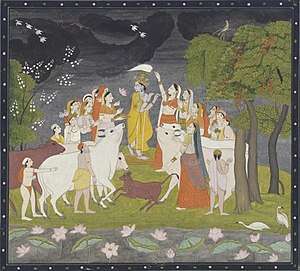
Krishna is represented in the Indian traditions in many ways, but with some common features. His iconography typically depicts him with black, dark, or blue skin, like Vishnu.[84] However, ancient and medieval reliefs and stone-based arts depict him in the natural color of the material out of which he is formed, both in India and in southeast Asia.[85][86] In some texts, his skin is poetically described as the color of Jambul (Jamun, a purple-colored fruit).[87]
Krishna is often depicted wearing a peacock-feather wreath or crown, and playing the bansuri (Indian flute).[88][89] In this form, he is usually shown standing with one leg bent in front of the other in the Tribhanga posture. He is sometimes accompanied by cows or a calf, which symbolise the divine herdsman Govinda. Alternatively, he is shown as a romantic young boy with the gopis (milkmaids), often making music or playing pranks.[90]

In other icons, he is a part of battlefield scenes of the epic Mahabharata. He is shown as a charioteer, notably when he is addressing the Pandava prince Arjuna character, symbolically reflecting the events that led to the Bhagavad Gita – a scripture of Hinduism. In these popular depictions, Krishna appears in the front as the charioteer, either as a counsel listening to Arjuna, or as the driver of the chariot while Arjuna aims his arrows in the battlefield of Kurukshetra.[92][93]
Alternate icons of Krishna show him as a baby (Bala Krishna, the child Krishna), a toddler crawling on his hands and knees, a dancing child, or an innocent-looking child playfully stealing or consuming butter (Makkan Chor),[59] holding Laddu in his hand (Laddu Gopal)[94][95] or as a cosmic infant sucking his toe while floating on a banyan leaf during the Pralaya (the cosmic dissolution) observed by sage Markandeya.[96] Regional variations in the iconography of Krishna are seen in his different forms, such as Jaganatha in Odisha, Vithoba in Maharashtra,[97] Shrinathji in Rajasthan[98] and Guruvayoorappan in Kerala.[99]
Guidelines for the preparation of Krishna icons in design and architecture are described in medieval-era Sanskrit texts on Hindu temple arts such as Vaikhanasa agama, Vishnu dharmottara, Brihat samhita, and Agni Purana.[100] Similarly, early medieval-era Tamil texts also contain guidelines for sculpting Krishna and Rukmini. Several statues made according to these guidelines are in the collections of the Government Museum, Chennai.[101]
Life and Legends
This summary is a mythological account, based on literary details from the Mahābhārata, the Harivamsa, the Bhagavata Purana, and the Vishnu Purana. The scenes from the narrative are set in ancient India, mostly in the present states of Uttar Pradesh, Bihar, Rajasthan, Haryana, Delhi, and Gujarat. The legends about Krishna's life are called Krishna charitas (IAST: Kṛṣṇacaritas).[102]
Birth
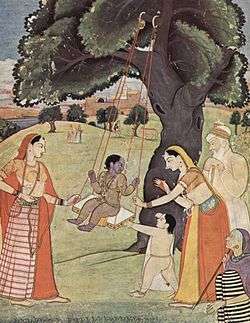
In the Krishna Charitas, Krishna is born to Devaki and her husband, Vasudeva of the Yadava clan in Mathura.[103] Devaki's brother is a tyrant named Kamsa. At Devaki's wedding, according to Puranic legends, Kamsa is told by fortune tellers that a child of Devaki would kill him. Kamsa arranges to kill all of Devaki's children. When Krishna is born, Vasudeva secretly carries the infant Krishna away across the Yamuna and exchanges him. When Kamsa tries to kill the newborn, the exchanged baby appears as the Hindu goddess Durga, warning him that his death has arrived in his kingdom, and then disappears, according to the legends in the Puranas. Krishna grows up with Nanda and his wife Yashoda near modern-day Mathura.[104][105][106] Two of Krishna's siblings also survive, namely Balarama and Subhadra, according to these legends.[107] The day of birth of Krishna is celebrated as Krishna Janmashtami.
Childhood and youth
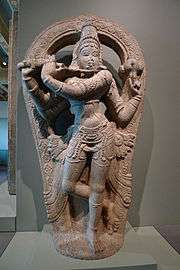
The legends of Krishna's childhood and youth describe him as a cow herder, a mischievous boy whose pranks earns him the nickname Makhan Chor (butter thief) and a protector who steals the hearts of the people in both Gokul and Vrindavana. The texts state, for example, that Krishna lifts the Govardhana hill to protect the inhabitants of Vrindavana from devastating rains and floods.[108]
Other legends describe him as an enchanter and playful lover of the gopis (milkmaids) of Vrindavana, especially Radha. These metaphor-filled love stories are known as the Rasa lila and were romanticised in the poetry of Jayadeva, author of the Gita Govinda. They are also central to the development of the Krishna bhakti traditions worshiping Radha Krishna.[109]
Krishna's childhood illustrates the Hindu concept of lila, playing for fun and enjoyment and not for sport or gain. His interaction with the gopis at the rasa dance or Rasa-lila is an example. Krishna plays his flute and the gopis come immediately, from whatever they were doing, to the banks of the Yamuna River and join him in singing and dancing. Even those who could not physically be there join him through meditation. He is the spiritual essence and the love-eternal in existence, the gopis metaphorically represent the prakṛti matter and the impermanent body.[110]:256
This lila is a constant theme in the legends of Krishna's childhood and youth. Even when he is battling with a serpent to protect others, he is described in Hindu texts as if he were playing a game.[110]:255 This quality of playfulness in Krishna is celebrated during festivals as Rasa-lila and Janmashtami, where Hindus in some regions such as Maharashtra playfully mimic his legends, such as by making human gymnastic pyramids to break open handis (clay pots) hung high in the air to "steal" butter or buttermilk, spilling it all over the group.[110]:253–261
Adulthood
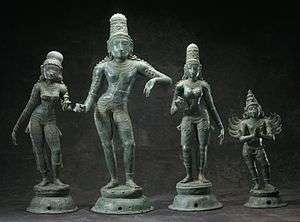
Krishna legends then describe his return to Mathura. He overthrows and kills the tyrant king, his uncle Kamsa/Kansa after quelling several assassination attempts by Kamsa. He reinstates Kamsa's father, Ugrasena as the king of the Yadavas and becomes a leading prince at the court.[112] In one version of the Krishna story, as narrated by Shanta Rao, Krishna after Kamsa's death leads the Yadavas to the newly built city of Dwaraka. Thereafter Pandavas rise. Krishna befriends Arjuna and the other Pandava princes of the Kuru kingdom. Krishna plays a key role in the Mahabharata.[113]
The Bhagavata Purana describes eight wives of Krishna that appear in sequence as (Rukmini, Satyabhama, Jambavati, Kalindi, Mitravinda, Nagnajiti (also called Satya), Bhadra and Lakshmana (also called Madra).[114] According to Dennis Hudson, this is a metaphor where each of the eight wives signifies a different aspect of him.[115] According to George Williams, Vaishnava texts mention all Gopis as wives of Krishna, but this is spiritual symbolism of devotional relationship and Krishna's complete loving devotion to each and everyone devoted to him.[116]
In Krishna-related Hindu traditions, he is most commonly seen with Radha. All of his wives and his lover Radha are considered in the Hindu tradition to be the avatars of the goddess Lakshmi, the consort of Vishnu.[117][5] Gopis are considered as Lakshmi's or Radha's manifestations.[5][118]
Kurukshetra War and Bhagavad Gita
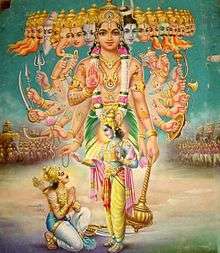
According to the epic poem Mahabharata, Krishna becomes Arjuna's charioteer for the Kurukshetra War, but on the condition that he personally will not raise any weapon. Upon arrival at the battlefield and seeing that the enemies are his family, his grandfather and his cousins and loved ones, Arjuna is moved and says his heart will not allow him to fight and kill others. He would rather renounce the kingdom and put down his Gandiv (Arjuna's bow). Krishna then advises him about the nature of life, ethics and morality when one is faced with a war between good and evil, the impermanence of matter, the permanence of the soul and the good, duties and responsibilities, the nature of true peace and bliss and the different types of yoga to reach this state of bliss and inner liberation. This conversation between Krishna and Arjuna is presented as a discourse called the Bhagavad Gita.[119][120][121]
Death and ascension
It is stated in the Indian texts that the legendary Kurukshetra War leads to the death of all the hundred sons of Gandhari. After Duryodhana's death, Krishna visits Gandhari to offer his condolences when Gandhari and Dhritarashtra visited Kurukshtra, as stated in Stree Parva. Feeling that Krishna deliberately did not put an end to the war, in a fit of rage and sorrow Gandhari said, 'Thou were indifferent to the Kurus and the Pandavas whilst they slew each other, therefore, O Govinda, thou shalt be the slayer of thy own kinsmen !' According to the Mahabharata, a fight breaks out at a festival among the Yadavas, who end up killing each other. Mistaking the sleeping Krishna for a deer, a hunter named Jara shoots an arrow that fatally injures him. Krishna forgives Jara and dies.[122][123][124] The pilgrimage (tirtha) site of Bhalka in Gujarat marks the location where Krishna is believed to have died. It is also known as Dehotsarga, states Diana L. Eck, a term that literally means the place where Krishna "gave up his body".[123] The Bhagavata Purana in Book 11, chapter 31 states that after his death, Krishna returned to his transcendent abode directly because of his yogic concentration. Waiting gods such as Brahma and Indra were unable to trace the path Krishna took to leave his human incarnation and return to his abode.[125][126]
Versions and interpretations
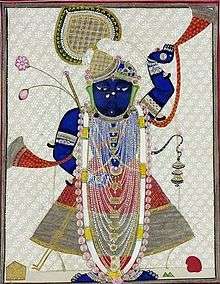
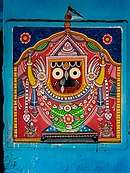
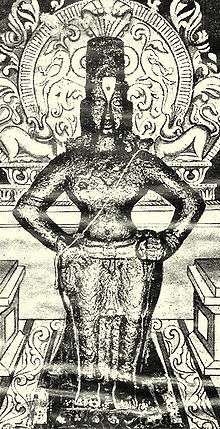
There are numerous versions of Krishna's life story, of which three are most studied: the Harivamsa, the Bhagavata Purana, and the Vishnu Purana.[127] They share the basic storyline but vary significantly in their specifics, details, and styles.[128] The most original composition, the Harivamsa is told in a realistic style that describes Krishna's life as a poor herder but weaves in poetic and allusive fantasy. It ends on a triumphal note, not with the death of Krishna.[129] Differing in some details, the fifth book of the Vishnu Purana moves away from Harivamsa realism and embeds Krishna in mystical terms and eulogies.[130] The Vishnu Purana manuscripts exist in many versions.[131]
The tenth and eleventh books of the Bhagavata Purana are widely considered to be a poetic masterpiece, full of imagination and metaphors, with no relation to the realism of pastoral life found in the Harivamsa. Krishna's life is presented as a cosmic play (lila), where his youth is set as a princely life with his foster father Nanda portrayed as a king.[132] Krishna's life is closer to that of a human being in Harivamsa, but is a symbolic universe in the Bhagavata Purana, where Krishna is within the universe and beyond it, as well as the universe itself, always.[133] The Bhagavata Purana manuscripts also exist in many versions, in numerous Indian languages.[134][82]
- Chaitanya Mahaprabhu is considered as the incarnation of Krishna in Gaudiya Vaishnavism and by the ISKCON community[135][136][137] Ramdev pir is considered as an incarnation of Krishna.[138]
Proposed datings
The date of Krishna's birth is celebrated every year as Janmashtami.[139]
According to Guy Beck, "most scholars of Hinduism and Indian history accept the historicity of Krishna—that he was a real male person, whether human or divine, who lived on Indian soil by at least 1000 BCE and interacted with many other historical persons within the cycles of the epic and puranic histories." Yet, Beck also notes that there is an "enormous number of contradictions and discrepancies surrounding the chronology of Krishna's life as depicted in the Sanskrit canon."[140]
Lanvanya Vemsani states that Krishna can be inferred to have lived between 3227 BCE – 3102 BCE from the Puranas.[141] A number of scholars, such as A. K. Bansal, B. V. Raman places Krishna's birth year as 3228 BCE.[142][143] A paper presented in a conference in 2004 by a group of archaeologists, religious scholars and astronomers from Somnath Trust of Gujarat, which was organised at Prabhas Patan, the supposed location of the where Krishna spent his last moments, fixes the death of Sri Krishna on 18 February 3102 BC at the age of 125 years and 7 months.[note 2]
In contrast, according to mythologies in the Jain tradition, Krishna was a cousin of Neminatha.[150] Neminatha is believed in the Jain tradition to have been born 84,000 years before the 9th-century BCE Parshvanatha, the twenty-third tirthankara.[151]
Philosophy and theology
A wide range of theological and philosophical ideas are presented through Krishna in Hindu texts. Ramanuja, a Hindu theologian whose works were influential in Bhakti movement,[152] presented him in terms of qualified monism (Vishishtadvaita).[153] Madhvacharya, a Hindu philosopher whose works led to the founding of Haridasa sect of Vaishnavism,[154] presented Krishna in the framework of dualism (Dvaita).[155] Jiva Goswami, a saint from Gaudiya Vaishnava school,[156] described Krishna theology in terms of Bhakti yoga and Achintya Bheda Abheda.[157] Krishna theology is presented in a pure monism (advaita, called shuddhadvaita) framework by Vallabha Acharya, who was the founder of Pushti sect of vaishnavism.[158][159] Madhusudana Sarasvati, an India philosopher,[160] presented Krishna theology in nondualism-monism framework (Advaita Vedanta), while Adi Shankara, who is credited for unifying and establishing the main currents of thought in Hinduism,[161][162][163] mentioned Krishna in his early eighth-century discussions on Panchayatana puja.[164]
The Bhagavata Purana, a popular text on Krishna considered to be like a scripture in Assam, synthesizes an Advaita, Samkhya, and Yoga framework for Krishna but one that proceeds through loving devotion to Krishna.[165][166][167] Bryant describes the synthesis of ideas in Bhagavata Purana as,
The philosophy of the Bhagavata is a mixture of Vedanta terminology, Samkhyan metaphysics and devotionalized Yoga praxis. (...) The tenth book promotes Krishna as the highest absolute personal aspect of godhead – the personality behind the term Ishvara and the ultimate aspect of Brahman.
— Edwin Bryant, Krishna: A Sourcebook[1]
While Sheridan and Pintchman both affirm Bryant's view, the latter adds that the Vedantic view emphasized in the Bhagavata is non-dualist with a difference. In conventional nondual Vedanta all reality is an interconnected and one, the Bhagavata posits that the reality is interconnected and plural.[168][169]
Across the various theologies and philosophies, the common theme presents Krishna as the essence and symbol of divine love, with human life and love as a reflection of the divine. The longing and love-filled legends of Krishna and the gopis, his playful pranks as a baby,[170] as well as his later dialogues with other characters, are philosophically treated as metaphors for the human longing for the divine and for meaning, and the play between the universals and the human soul.[171][172][173] Krishna's lila is a theology of love-play. According to John Koller, "love is presented not simply as a means to salvation, it is the highest life". Human love is God's love.[174]
Other texts that include Krishna such as the Bhagavad Gita have attracted numerous bhasya (commentaries) in the Hindu traditions.[175] Though only a part of the Hindu epic Mahabharata, it has functioned as an independent spiritual guide. It allegorically raises through Krishna and Arjuna the ethical and moral dilemmas of human life, then presents a spectrum of answers, weighing in on the ideological questions on human freedoms, choices, and responsibilities towards self and towards others.[175][176] This Krishna dialogue has attracted numerous interpretations, from being a metaphor of inner human struggle teaching non-violence, to being a metaphor of outer human struggle teaching a rejection of quietism to persecution.[175][176][177]
Influence
Vaishnavism
| Part of a series on |
| Vaishnavism |
|---|
 |
|
Holy scriptures
|
|
Sampradayas
|
|
Related traditions |
|
|
The worship of Krishna is part of Vaishnavism, a major tradition within Hinduism. Krishna is considered a full avatar of Vishnu, or one with Vishnu himself.[178] However, the exact relationship between Krishna and Vishnu is complex and diverse,[179] with Krishna sometimes considered an independent deity and supreme.[180] Vaishnavas accept many incarnations of Vishnu, but Krishna is particularly important. Their theologies are generally centered either on Vishnu or an avatar such as Krishna as supreme. The terms Krishnaism and Vishnuism have sometimes been used to distinguish the two, the former implying that Krishna is the transcendent Supreme Being.[181]
All Vaishnava traditions recognise Krishna as the eighth avatar of Vishnu; others identify Krishna with Vishnu, while traditions such as Gaudiya Vaishnavism,[182][183] Vallabha Sampradaya and the Nimbarka Sampradaya regard Krishna as the Svayam Bhagavan, the original form of Lord or the same as the concept of Brahman in Hinduism.[2][185][186][187] Gitagovinda of Jayadeva considers Krishna to be the supreme lord while the ten incarnations are his forms. Swaminarayan, the founder of the Swaminarayan Sampraday, also worshipped Krishna as God himself. "Greater Krishnaism" corresponds to the second and dominant phase of Vaishnavism, revolving around the cults of the Vasudeva, Krishna, and Gopala of the late Vedic period.[188] Today the faith has a significant following outside of India as well.[189]
Early traditions
The deity Krishna-Vasudeva (kṛṣṇa vāsudeva "Krishna, the son of Vasudeva Anakadundubhi") is historically one of the earliest forms of worship in Krishnaism and Vaishnavism.[17][65] It is believed to be a significant tradition of the early history of Krishna religion in antiquity.[190] Thereafter, there was an amalgamation of various similar traditions. These include ancient Bhagavatism, the cult of Gopala, of "Krishna Govinda" (cow-finding Krishna), of Balakrishna (baby Krishna) and of "Krishna Gopivallabha" (Krishna the lover).[191][192] According to Andre Couture, the Harivamsa contributed to the synthesis of various characters as aspects of Krishna.[193]
Bhakti tradition
.jpg)
The use of the term bhakti, meaning devotion, is not confined to any one deity. However, Krishna is an important and popular focus of the devotionalism tradition within Hinduism, particularly among the Vaishnava sects.[182][194] Devotees of Krishna subscribe to the concept of lila, meaning 'divine play', as the central principle of the universe. It is a form of bhakti yoga, one of three types of yoga discussed by Krishna in the Bhagavad Gita.[183][195][196]
Indian subcontinent
The bhakti movements devoted to Krishna became prominent in southern India in the 7th to 9th centuries CE. The earliest works included those of the Alvar saints of the Tamil Nadu.[197] A major collection of their works is the Divya Prabandham. The Alvar Andal's popular collection of songs Tiruppavai, in which she conceives of herself as a gopi, is the most famous of the oldest works in this genre.[198][199][200]
The movement originated in South India during the 7th CE, spreading northwards from Tamil Nadu through Karnataka and Maharashtra; by the 15th century, it was established in Bengal and northern India.[201] Early Bhakti pioneers include Nimbarka (12th or 13th century CE),[202] but most emerged later, including Vallabhacharya (15th century CE) and (Lord Sri Chaitanya Mahaprabhu. They started their own schools, namely Nimbarka Sampradaya, Vallabha Sampradaya, and Gaudiya Vaishnavism, with Krishna as the supreme god.
In the Deccan, particularly in Maharashtra, saint poets of the Varkari sect such as Dnyaneshwar, Namdev, Janabai, Eknath, and Tukaram promoted the worship of Vithoba,[97] a local form of Krishna, from the beginning of the 13th century until the late 18th century.[15] In southern India, Purandara Dasa and Kanakadasa of Karnataka composed songs devoted to the Krishna image of Udupi. Rupa Goswami of Gaudiya Vaishnavism has compiled a comprehensive summary of bhakti called Bhakti-rasamrita-sindhu.[194]
In South India, the acharyas of the Sri Sampradaya have written reverentially about Krishna in most of their works, including the Thiruppavai by Andal[203] and Gopala Vimshati by Vedanta Desika.[204]
Tamil Nadu, Karnataka, Andhra Pradesh, and Kerala states have many major Krishna temples, and Janmashtami is one of the widely celebrated festivals in South India.[205]
Outside Asia
By 1965 the Krishna-bhakti movement had spread outside India after Bhaktivedanta Swami Prabhupada (as instructed by his guru, Bhaktisiddhanta Sarasvati Thakura) traveled from his homeland in West Bengal to New York City. A year later in 1966, after gaining many followers, he was able to form the International Society for Krishna Consciousness (ISKCON), popularly known as the Hare Krishna movement. The purpose of this movement was to write about Krishna in English and to share the Gaudiya Vaishnava philosophy with people in the Western world by spreading the teachings of the saint Chaitanya Mahaprabhu. In the biographies of Chaitanya Mahaprabhu, the mantra he received when he was given diksha or initiation in Gaya was the six-word verse of the Kali-Santarana Upanishad, namely "Hare Krishna Hare Krishna, Krishna Krishna Hare Hare; Hare Rama Hare Rama, Rama Rama Hare Hare". In Gaudiya tradition, it is the maha-mantra, or great mantra, about Krishna bhakti.[206][207] Its chanting was known as hari-nama sankirtana.[208]
The maha-mantra gained the attention of George Harrison and John Lennon of The Beatles fame,[209] and Harrison produced a 1969 recording of the mantra by devotees from the London Radha Krishna Temple.[210] Titled "Hare Krishna Mantra", the song reached the top twenty on the UK music charts and was also successful in West Germany and Czechoslovakia.[209][211] The mantra of the Upanishad thus helped bring Bhaktivedanta and ISKCON ideas about Krishna into the West.[209] ISCKON has built many Krishna temples in the West, as well as other locations such as South Africa.[212]
Southeast Asia
Krishna is found in southeast Asian history and art, but to a far less extent than Shiva, Durga, Nandi, Agastya, and Buddha. In temples (candi) of the archaeological sites in hilly volcanic Java, Indonesia, temple reliefs do not portray his pastoral life or his role as the erotic lover, nor do the historic Javanese Hindu texts.[215] Rather, either his childhood or the life as a king and Arjuna's companion have been more favored. The most elaborate temple arts of Krishna are found in a series of Krsnayana reliefs in the Prambanan Hindu temple complex near Yogyakarta. These are dated to the 9th century CE.[215][216][217] Krishna remained a part of the Javanese cultural and theological fabric through the 14th century, as evidenced by the 14th-century Penataran reliefs along with those of the Hindu god Rama in east Java, before Islam replaced Buddhism and Hinduism on the island.[218]
The medieval era arts of Vietnam and Cambodia feature Krishna. The earliest surviving sculptures and reliefs are from the 6th and 7th century, and these include Vaishnavism iconography.[213] According to John Guy, the curator and director of southeast Asian arts at the Metropolitan Museum of Art, the Krishna Govardhana art from 6th/7th-century Vietnam at Danang, and 7th-century Cambodia at Phnom Da cave in Angkor Borei, are some of the most sophisticated of this era.[213]
Krishna iconography has also been found in Thailand, along with those of Surya and Vishnu. For example, a large number of sculptures and icons have been found in the Si Thep and Klangnai sites in the Phetchabun region of northern Thailand. These are dated to about the 7th and 8th century, from both the Funan and Zhenla periods archaeological sites.[219]
In popular culture
Performance arts
Indian dance and music theatre traces its origins and techniques to the ancient Sama Veda and Natyasastra texts.[220][221] The stories enacted and the numerous choreographic themes are inspired by the mythologies and legends in Hindu texts, including Krishna-related literature such as Harivamsa and Bhagavata Purana.[222]
The Krishna stories have played a key role in the history of Indian theatre, music, and dance, particularly through the tradition of Rasaleela. These are dramatic enactments of Krishna's childhood, adolescence, and adulthood. One common scene involves Krishna playing flute in rasa leela, only to be heard by certain gopis (cowheard maidens), which is theologically supposed to represent divine call only heard by certain enlightened beings.[223] Some of the text's legends have inspired secondary theatre literature such as the eroticism in Gita Govinda.[224]
Krishna-related literature such as the Bhagavata Purana accords a metaphysical significance to the performances and treats them as religious ritual, infusing daily life with spiritual meaning, thus representing a good, honest, happy life. Similarly, Krishna-inspired performances aim to cleanse the hearts of faithful actors and listeners. Singing, dancing, and performance of any part of Krishna Lila is an act of remembering the dharma in the text, as a form of para bhakti (supreme devotion). To remember Krishna at any time and in any art, asserts the text, is to worship the good and the divine.[225]
Classical dance styles such as Kathak, Odissi, Manipuri, Kuchipudi and Bharatanatyam in particular are known for their Krishna-related performances.[226] Krisnattam (Krishnattam) traces its origins to Krishna legends, and is linked to another major classical Indian dance form called Kathakali.[227] Bryant summarizes the influence of Krishna stories in the Bhagavata Purana as, "[it] has inspired more derivative literature, poetry, drama, dance, theatre and art than any other text in the history of Sanskrit literature, with the possible exception of the Ramayana.[19]
In television and films
Krishna has many facets to his personality, and numerous TV shows and films have, over the years, tried to capture his essence. A number of actors have essayed also the role of Lord Krishna.
Television
Films
Krishna outside of Hinduism
Jainism
The Jainism tradition lists 63 Śalākāpuruṣa or notable figures which, amongst others, includes the twenty-four Tirthankaras (spiritual teachers) and nine sets of triads. One of these triads is Krishna as the Vasudeva, Balarama as the Baladeva, and Jarasandha as the Prati-Vasudeva. In each age of the Jain cyclic time is born a Vasudeva with an elder brother termed the Baladeva. Between the triads, Baladeva upholds the principle of non-violence, a central idea of Jainism. The villain is the Prati-vasudeva, who attempts to destroy the world. To save the world, Vasudeva-Krishna has to forsake the non-violence principle and kill the Prati-Vasudeva.[229] The stories of these triads can be found in the Harivamsa Purana (8th century CE) of Jinasena (not be confused with its namesake, the addendum to Mahābhārata) and the Trishashti-shalakapurusha-charita of Hemachandra.[230][231]
The story of Krishna's life in the Puranas of Jainism follows the same general outline as those in the Hindu texts, but in details they are very different: they include Jain Tirthankaras as characters in the story, and generally are polemically critical of Krishna, unlike the versions found in the Mahabharata, the Bhagavata Purana, and the Vishnu Purana.[232] For example, Krishna loses battles in the Jain versions, and his gopis and his clan of Yadavas die in a fire created by an ascetic named Dvaipayana. Similarly, after dying from the hunter Jara's arrow, the Jaina texts state Krishna goes to the third hell in Jain cosmology, while his brother is said to go to the sixth heaven.[233]
Vimalasuri is attributed to be the author of the Jain version of the Harivamsa Purana, but no manuscripts have been found that confirm this. It is likely that later Jain scholars, probably Jinasena of the 8th century, wrote a complete version of Krishna legends in the Jain tradition and credited it to the ancient Vimalasuri.[234] Partial and older versions of the Krishna story are available in Jain literature, such as in the Antagata Dasao of the Svetambara Agama tradition.[234]
In other Jain texts, Krishna is stated to be a cousin of the twenty-second tirthankara, Neminatha. The Jain texts state that Neminatha taught Krishna all the wisdom that he later gave to Arjuna in the Bhagavad Gita. According to Jeffery D. Long, a professor of religion known for his publications on Jainism, this connection between Krishna and Neminatha has been a historic reason for Jains to accept, read, and cite the Bhagavad Gita as a spiritually important text, celebrate Krishna-related festivals, and intermingle with Hindus as spiritual cousins.[235]
Buddhism
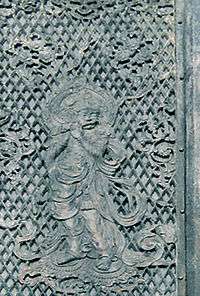
The story of Krishna occurs in the Jataka tales in Buddhism.[236] The Vidhurapandita Jataka mentions Madhura (Sanskrit: Mathura), the Ghata Jataka mentions Kamsa, Devagabbha (Sk: Devaki), Upasagara or Vasudeva, Govaddhana (Sk: Govardhana), Baladeva (Balarama), and Kanha or Kesava (Sk: Krishna, Keshava).[237][238]
Like the Jaina versions of the Krishna legends, the Buddhist versions such as one in Ghata Jataka follow the general outline of the story,[239] but are different from the Hindu versions as well.[237][72] For example, the Buddhist legend describes Devagabbha (Devaki) to have been isolated in a palace built upon a pole, after she is born, so no future husband could reach her. Krishna's father similarly is described as a powerful king, but who meets up with Devagabbha anyway, and to whom Kamsa gives away his sister Devagabbha in marriage. The siblings of Krishna are not killed by Kamsa, though he tries. In the Buddhist version of the legend, all of Krishna's siblings grow to maturity.[240]
Krishna and his siblings' capital becomes Dvaravati. The Arjuna and Krishna interaction is missing in the Jataka version. A new legend is included, wherein Krishna laments in uncontrollable sorrow when his son dies, and a Ghatapandita feigns madness to teach Krishna a lesson.[241] The Jataka tale also includes an internecine destruction among his siblings after they all get drunk. Krishna also dies in the Buddhist legend by the hand of a hunter named Jara, but while he is traveling to a frontier city. Mistaking Krishna for a pig, Jara throws a spear that fatally pierces his feet, causing Krishna great pain and then his death.[240]
At the end of this Ghata-Jataka discourse, the Buddhist text declares that Sariputta, one of the revered disciples of the Buddha in the Buddhist tradition, was incarnated as Krishna in his previous life to learn lessons on grief from the Buddha in his prior rebirth:
Then he [Master] declared the Truths, and identified the Birth: 'At that time, Ananda was Rohineyya, Sariputta was Vasudeva [Krishna], the followers of the Buddha were the other persons, and I myself was Ghatapandita."
— Jataka Tale No. 454, Translator: W. H. D. Rouse[242]
While the Buddhist Jataka texts co-opt Krishna-Vasudeva and make him a student of the Buddha in his previous life,[242] the Hindu texts co-opt the Buddha and make him an avatar of Vishnu.[243][244] The 'divine boy' Krishna as an embodiment of wisdom and endearing prankster forms a part of the pantheon of gods in Japanese Buddhism.[245]
Other
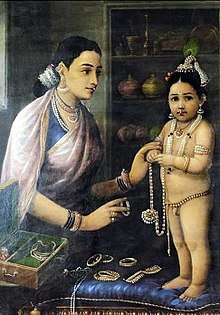
Krishna is mentioned as Krishna Avtar in the Chaubis Avtar, a composition in Dasam Granth traditionally and historically attributed to Guru Gobind Singh.[246]
Bahá'ís believe that Krishna was a "Manifestation of God", or one in a line of prophets who have revealed the Word of God progressively for a gradually maturing humanity. In this way, Krishna shares an exalted station with Abraham, Moses, Zoroaster, Buddha, Muhammad, Jesus, the Báb, and the founder of the Bahá'í Faith, Bahá'u'lláh.[247][248]
Ahmadiyya, a 20th-century Islamic movement, consider Krishna as one of their ancient prophets.[249][250][251] Ghulam Ahmad stated that he was himself a prophet in the likeness of prophets such as Krishna, Jesus, and Muhammad,[252] who had come to earth as a latter-day reviver of religion and morality.
Krishna worship or reverence has been adopted by several new religious movements since the 19th century, and he is sometimes a member of an eclectic pantheon in occult texts, along with Greek, Buddhist, biblical, and even historical figures.[253] For instance, Édouard Schuré, an influential figure in perennial philosophy and occult movements, considered Krishna a Great Initiate, while Theosophists regard Krishna as an incarnation of Maitreya (one of the Masters of the Ancient Wisdom), the most important spiritual teacher for humanity along with Buddha.[254][255]
Krishna was canonised by Aleister Crowley and is recognised as a saint of Ecclesia Gnostica Catholica in the Gnostic Mass of Ordo Templi Orientis.[256][257]
Notes
- The regional texts vary in the identity of Krishna's wife (consort), some presenting it as Rukmini, some as Radha, some as Svaminiji, some adding all gopis, and some identifying all to be different aspects or manifestation of Devi Lakshmi.[4][5]
- Scholars such as Ludo Rocher and Hazra state that the Puranas are not a reliable source for Indian history, because the content therein about kings, various peoples, sages, and kingdoms is highly inconsistent across the manuscripts. They state that these stories are probably based in part on real events, in part on hagiography, and in part embellished by expansive imagination.[144][145] Dimmitt and van Buitenen state that it is difficult to ascertain when, where, why and by whom the Puranas were written, and they grew by "numerous accretions in successive historical eras" where people added or changed the text at random.[146] Their reliability has also suffered from the way surviving manuscripts were copied over the centuries.[147][148] The liberties in the transmission of Puranas were normal and those who copied older manuscripts replaced words or added new content.[148][149]
See also
- Jai Shri Krishna - a Hindi expression glorifying Krishna and also used to greet each other
References
Citations
- Bryant 2007, p. 114.
- K. Klostermaier (1997). The Charles Strong Trust Lectures, 1972–1984. Crotty, Robert B. Brill Academic Pub. p. 109. ISBN 978-90-04-07863-5.
"(...) After attaining to fame eternal, he again took up his real nature as Brahman. The most important among Visnu's avataras is undoubtedly Krsna, the black one, also called Syama. For his worshippers he is not an avatara in the usual sense, but Svayam Bhagavan, the Lord himself.
- Raychaudhuri 1972, p. 124
- John Stratton Hawley, Donna Marie Wulff (1982). The Divine Consort: Rādhā and the Goddesses of India. Motilal Banarsidass Publisher. p. 12. ISBN 978-0-89581-102-8.
- Bryant 2007, p. 443.
- Pradyumna. ACK Private Limited. ISBN 81-8482-340-1.
- "Krishna". Random House Webster's Unabridged Dictionary.
- "Krishna". Encyclopædia Britannica Online.
- Ben-Ami Scharfstein (1993). Ineffability: The Failure of Words in Philosophy and Religion. State University of New York Press. p. 166. ISBN 978-0-7914-1347-0.
- Edwin Bryant & Maria Ekstrand 2004, pp. 21–24.
- Edwin Bryant & Maria Ekstrand 2004, pp. 20–25, quote: "Three Dimensions of Krishna's Divinity (...) divine majesty and supremacy; (...) divine tenderness and intimacy; (...) compassion and protection.; (..., p.24) Krishna as the God of Love".
- Freda Matchett (2001). Krishna, Lord Or Avatara?. Psychology Press. p. 199. ISBN 978-0-7007-1281-6.
- James G. Lochtefeld (2002). The Illustrated Encyclopedia of Hinduism: A-M. The Rosen Publishing Group. pp. 314–315. ISBN 978-0-8239-3179-8.
- Richard Thompson, Ph.D. (December 1994). "Reflections on the Relation Between Religion and Modern Rationalism". Archived from the original on 4 January 2011. Retrieved 12 April 2008. Cite journal requires
|journal=(help) - Mahony, W. K. (1987). "Perspectives on Krsna's Various Personalities". History of Religions. 26 (3): 333–335. doi:10.1086/463085. JSTOR 1062381.CS1 maint: ref=harv (link), Quote: "Krsna's various appearances as a divine hero, alluring god child, cosmic prankster, perfect lover, and universal supreme being (...)".
- Knott 2000, pp. 15, 36, 56
- Hein, Norvin (1986). "A Revolution in Kṛṣṇaism: The Cult of Gopāla". History of Religions. 25 (4): 296–317. doi:10.1086/463051. JSTOR 1062622.
- Ravi Gupta and Kenneth Valpey (2013), The Bhagavata Purana, Columbia University Press, ISBN 978-0231149990, pages 185–200
- Bryant 2007, pp. 118.
- ML Varadpande (1987), History of Indian Theatre, Vol 1, Abhinav, ISBN 978-8170172215, pages 98–99
- J. Gordon Melton (2011). Religious Celebrations: An Encyclopedia of Holidays, Festivals, Solemn Observances, and Spiritual Commemorations. ABC-CLIO. pp. 330–331. ISBN 978-1-59884-205-0.
- Cynthia Packert (2010). The Art of Loving Krishna: Ornamentation and Devotion. Indiana University Press. pp. 5, 70–71, 181–187. ISBN 978-0-253-22198-8.
- Bryant 2007, p. 3.
- Lavanya Vemsani (2016). Krishna in History, Thought, and Culture. ABC-CLIO. pp. 112–113. ISBN 978-1-61069-211-3.
- Selengut, Charles (1996). "Charisma and Religious Innovation:Prabhupada and the Founding of ISKCON". ISKCON Communications Journal. 4 (2). Archived from the original on 10 July 2012.CS1 maint: ref=harv (link)
- Bryant 2007, p. 382
- Monier Monier Williams, Go-vinda, Sanskrit English Dictionary and Ettymology, Oxford University Press, p. 336, 3rd column
- Bryant 2007, p. 17
- Hiltebeitel, Alf (2001). Rethinking the Mahābhārata: a reader's guide to the education of the dharma king. Chicago: University of Chicago Press. pp. 251–53, 256, 259. ISBN 978-0-226-34054-8.
- B. M. Misra (18 June 2007). Orissa: Shri Krishna Jagannatha: the Mushali parva from Sarala's Mahabharata. Oxford University Press, USA. ISBN 978-0-19-514891-6.
- Bryant 2007, p. 139.
- For the historic Jagannath temple in Ranchi, Jharkhand see: Francis Bradley Bradley-Birt (1989). Chota Nagpur, a Little-known Province of the Empire. Asian Educational Services (Orig: 1903). pp. 61–64. ISBN 978-81-206-1287-7.
- Flood, Gavin D. (1996). An Introduction to Hinduism. Cambridge University Press. p. 119-120. ISBN 978-0-521-43878-0.
- Singh, Upinder (2008). A History of Ancient and Early Medieval India: From the Stone Age to the 12th Century. Pearson Education India. p. 436–438. ISBN 978-81-317-1120-0.
- Osmund Bopearachchi, Emergence of Viṣṇu and Śiva Images in India: Numismatic and Sculptural Evidence, 2016.
- Srinivasan, Doris (1997). Many Heads, Arms, and Eyes: Origin, Meaning, and Form of Multiplicity in Indian Art. BRILL. p. 215. ISBN 978-90-04-10758-8.
- Osmund Bopearachchi (2016). "Emergence of Viṣṇu and Śiva Images in India: Numismatic and Sculptural Evidence".
- Audouin, Rémy, and Paul Bernard, "Trésor de monnaies indiennes et indo-grecques d'Aï Khanoum (Afghanistan). II. Les monnaies indo-grecques." Revue numismatique 6, no. 16 (1974), pp. 6–41 (in French).
- Nilakanth Purushottam Joshi, Iconography of Balarāma, Abhinav Publications, 1979, p. 22
- F. R. Allchin; George Erdosy (1995). The Archaeology of Early Historic South Asia: The Emergence of Cities and States. Cambridge University Press. pp. 309–310. ISBN 978-0-521-37695-2.
- L. A. Waddell (1914), Besnagar Pillar Inscription B Re-Interpreted, The Journal of the Royal Asiatic Society of Great Britain and Ireland, Cambridge University Press, pp. 1031–1037
- Richard Salomon (1998). Indian Epigraphy: A Guide to the Study of Inscriptions in Sanskrit, Prakrit, and the other Indo-Aryan Languages. Oxford University Press. pp. 265–267. ISBN 978-0-19-535666-3.
- Benjamín Preciado-Solís (1984). The Kṛṣṇa Cycle in the Purāṇas: Themes and Motifs in a Heroic Saga. Motilal Banarsidass. p. 34. ISBN 978-0-89581-226-1.
- M D Khare 1967.
- John Irwin 1974, pp. 169-176 with Figure 2 and 3.
- Susan V Mishra & Himanshu P Ray 2017, p. 5.
- Burjor Avari (2016). India: The Ancient Past: A History of the Indian Subcontinent from C. 7000 BCE to CE 1200. Routledge. pp. 165–167. ISBN 978-1-317-23673-3.
- Srinivasan, Doris (1997). Many Heads, Arms, and Eyes: Origin, Meaning, and Form of Multiplicity in Indian Art. BRILL. p. 215. ISBN 978-90-04-10758-8.
- Bhattacharya, Sunil Kumar (1996). Krishna-cult in Indian Art. M.D. Publications Pvt. Ltd. p. 27. ISBN 978-81-7533-001-6.
- Richard Salomon (1998). Indian Epigraphy: A Guide to the Study of Inscriptions in Sanskrit, Prakrit, and the Other Indo-Aryan Languages. Oxford University Press. pp. 86–87. ISBN 978-0-19-509984-3.
- Manohar Laxman Varadpande (1982). Krishna Theatre in India. Abhinav Publications. pp. 6–7. ISBN 978-81-7017-151-5.
- Barnett, Lionel David (1922). Hindu Gods and Heroes: Studies in the History of the Religion of India. J. Murray. p. 93.
- Puri, B. N. (1968). India in the Time of Patanjali. Bhartiya Vidya Bhavan.Page 51: The coins of Rajuvula have been recovered from the Sultanpur District...the Brahmi inscription on the Mora stone slab, now in the Mathura Museum,
- Doris Srinivasan (1997). Many Heads, Arms, and Eyes: Origin, Meaning, and Form of Multiplicity in Indian Art. BRILL Academic. pp. 214–215 with footnotes. ISBN 90-04-10758-4.
- Jason Neelis (2010). Early Buddhist Transmission and Trade Networks: Mobility and Exchange Within and Beyond the Northwestern Borderlands of South Asia. BRILL Academic. pp. 271–272. ISBN 978-90-04-18159-5.
- Wendy Doniger (2008). "Britannica: Mahabharata". encyclopedia. Encyclopædia Britannica Online. Retrieved 13 October 2008.
- Maurice Winternitz (1981), History of Indian Literature, Vol. 1, Delhi, Motilal Banarsidass, ISBN 978-0836408010, pages 426–431
- John Stratton Hawley (2014). Krishna, The Butter Thief. Princeton University Press. pp. 3–8. ISBN 978-1-4008-5540-7.
- Natubhai Shah 2004, p. 23.
- Max Müller, Chandogya Upanishad 3.16–3.17, The Upanishads, Part I, Oxford University Press, pages 50–53 with footnotes
- Edwin Bryant and Maria Ekstrand (2004), The Hare Krishna Movement, Columbia University Press, ISBN 978-0231122566, pages 33–34 with note 3
- Sandilya Bhakti Sutra SS Rishi (Translator), Sree Gaudia Math (Madras)
- WG Archer (2004), The Loves of Krishna in Indian Painting and Poetry, Dover, ISBN 978-0486433714, page 5
- Bryant 2007, p. 4
- Sunil Kumar Bhattacharya Krishna-cult in Indian Art. 1996 M. D. Publications Pvt. Ltd. ISBN 81-7533-001-5 p.128: Satha-patha-brahmana and Aitareya-Aranyaka with reference to first chapter.
- Archived 17 February 2012 at the Wayback Machine
- Pâṇ. IV. 3. 98, Vâsudevârjunâbhyâm vun. See Bhandarkar, Vaishnavism and Śaivism, p. 3 and J.R.A.S. 1910, p. 168. Sûtra 95, just above, appears to point to bhakti, faith or devotion, felt for this Vâsudeva.
- Sunil Kumar Bhattacharya Krishna-cult in Indian Art. 1996 M. D. Publications Pvt. Ltd. ISBN 81-7533-001-5 p.1
- Bryant 2007, p. 5.
- Bryant 2007, pp. 5–6.
- Bryant 2007, p. 6.
- Hemacandra Abhidhânacintâmani, Ed. Boehtlingk and Rien, p. 128, and Barnett's translation of the Antagada Dasāo, pp. 13–15 and 67–82.
- Bryant 2007, p. 5
- Gopal, Madan (1990). K.S. Gautam (ed.). India through the ages. Publication Division, Ministry of Information and Broadcasting, Government of India. p. 73.
- Flood, Gavin D. (1996). An Introduction to Hinduism. Cambridge University Press. p. 110-111. ISBN 978-0-521-43878-0.
- Elkman, S. M.; Gosvami, J. (1986). Jiva Gosvamin's Tattvasandarbha: A Study on the Philosophical and Sectarian Development of the Gaudiya Vaisnava Movement. Motilal Banarsidass.
- Rocher 1986, pp. 18, 49–53, 245–249.
- Gregory Bailey (2003). Arvind Sharma (ed.). The Study of Hinduism. University of South Carolina Press. pp. 141–142. ISBN 978-1-57003-449-7.
- Barbara Holdrege (2015), Bhakti and Embodiment, Routledge, ISBN 978-0415670708, pp. 109–110
- Richard Thompson (2007), The Cosmology of the Bhagavata Purana 'Mysteries of the Sacred Universe, Motilal Banarsidass, ISBN 978-8120819191
- Bryant 2007, p. 112.
- Matchett 2001, pp. 127–137.
- T. Richard Blurton (1993). Hindu Art. Harvard University Press. pp. 133–134. ISBN 978-0-674-39189-5.
- Guy, John (7 April 2014). Lost Kingdoms: Hindu-Buddhist Sculpture of Early Southeast Asia. Metropolitan Museum of Art. pp. 222–223. ISBN 978-1-58839-524-5.
- [a] Cooler, Richard M. (1978). "Sculpture, Kingship, and the Triad of Phnom Da". Artibus Asiae. 40 (1): 29–40. doi:10.2307/3249812. JSTOR 3249812.;
[b] Bertrand Porte (2006), "La statue de Kṛṣṇa Govardhana du Phnom Da du Musée National de Phnom Penh." UDAYA, Journal of Khmer Studies, Volume 7, pages 199-205 - Vishvanatha, Cakravarti Thakura (2011). Sarartha-darsini (Bhanu Swami ed.). Sri Vaikunta Enterprises. p. 790. ISBN 978-81-89564-13-1.
- The Encyclopedia Americana. [s.l.]: Grolier. 1988. p. 589. ISBN 978-0-7172-0119-8.
- Benton, William (1974). The New Encyclopædia Britannica. Encyclopædia Britannica. p. 885. ISBN 978-0-85229-290-7.
- Harle, J. C. (1994). The art and architecture of the Indian Subcontinent. New Haven, Conn: Yale University Press. p. 410. ISBN 978-0-300-06217-5.
figure 327. Manaku, Radha's messenger describing Krishna standing with the cow-girls, gopi from Basohli.
- Diana L. Eck (1982). Banaras, City of Light. Columbia University Press. pp. 66–67. ISBN 978-0-231-11447-9.
- Ariel Glucklich (2008). The Strides of Vishnu: Hindu Culture in Historical Perspective. Oxford University Press. p. 106. ISBN 978-0-19-971825-2.
- T. A. Gopinatha Rao (1993). Elements of Hindu iconography. Motilal Banarsidass. pp. 210–212. ISBN 978-81-208-0878-2.
- Hoiberg, Dale; Ramchandani, Indu (2000). Students' Britannica India. Popular Prakashan. p. 251. ISBN 978-0-85229-760-5.
- Satsvarupa dasa Goswami (1998). The Qualities of Sri Krsna. GNPress. pp. 152 pages. ISBN 978-0-911233-64-3.CS1 maint: ref=harv (link)
- Stuart Cary Welch (1985). India: Art and Culture, 1300–1900. Metropolitan Museum of Art. p. 58. ISBN 978-0-03-006114-1.
- Vithoba is not only viewed as a form of Krishna. He is also by some considered that of Vishnu, Shiva and Gautama Buddha according to various traditions. See: Kelkar, Ashok R. (2001) [1992]. "Sri-Vitthal: Ek Mahasamanvay (Marathi) by R. C. Dhere". Encyclopaedia of Indian literature. 5. Sahitya Akademi. p. 4179. ISBN 9788126012213. Retrieved 20 September 2008. and Mokashi, Digambar Balkrishna; Engblom, Philip C. (1987). Palkhi: a pilgrimage to Pandharpur — translated from the Marathi book Pālakhī by Philip C. Engblom. Albany: State University of New York Press. p. 35. ISBN 978-0-88706-461-6.
- Tryna Lyons (2004). The Artists of Nathadwara: The Practice of Painting in Rajasthan. Indiana University Press. pp. 16–22. ISBN 978-0-253-34417-5.
- Kunissery Ramakrishnier Vaidyanathan (1992). Sri Krishna, the Lord of Guruvayur. Bharatiya Vidya Bhavan. pp. 2–5.
- T. A. Gopinatha Rao (1993). Elements of Hindu iconography. Motilal Banarsidass. pp. 201–204. ISBN 978-81-208-0878-2.
- T. A. Gopinatha Rao (1993). Elements of Hindu iconography. Motilal Banarsidass. pp. 204–208. ISBN 978-81-208-0878-2.
- Matchett 2001, p. 145.
- The Poems of Sūradāsa. Abhinav publications. 1999. ISBN 9788170173694.
- "Yashoda and Krishna". Metmuseum.org. 10 October 2011. Archived from the original on 13 October 2008. Retrieved 23 October 2011.
- Sanghi, Ashwin (2012). The Krishna key. Chennai: Westland. p. Key7. ISBN 9789381626689. Retrieved 9 June 2016.
- Lok Nath Soni (2000). The Cattle and the Stick: An Ethnographic Profile of the Raut of Chhattisgarh. Anthropological Survey of India, Government of India, Ministry of Tourism and Culture, Department of Culture, Delhi: Anthropological Survey of India, Government of India, Ministry of Tourism and Culture, Department of Culture, 2000 Original from the University of Michigan. p. 16. ISBN 978-8185579573.
- Bryant 2007, pp. 124–130,224
- Lynne Gibson (1999). Merriam-Webster's Encyclopedia of World Religions. Merriam-Webster. p. 503.
- Schweig, G. M. (2005). Dance of divine love: The Rasa Lila of Krishna from the Bhagavata Purana, India's classic sacred love story. Princeton University Press, Princeton, NJ; Oxford. ISBN 978-0-691-11446-0.
- Largen, Kristin Johnston (September 2011). God at Play: Seeing God Through the Lens of the Young Krishna. Wiley-Blackwell.
- "Krishna Rajamannar with His Wives, Rukmini and Satyabhama, and His Mount, Garuda | LACMA Collections". collections.lacma.org. Retrieved 23 September 2014.
- Bryant 2007, p. 290
- Rao, Shanta Rameshwar (2005). Krishna. New Delhi: Orient Longman. p. 108. ISBN 9788125026969.
- D Dennis Hudson (27 August 2008). The Body of God : An Emperor's Palace for Krishna in Eighth-Century Kanchipuram: An Emperor's Palace for Krishna in Eighth-Century Kanchipuram. Oxford University Press. pp. 263–4. ISBN 978-0-19-970902-1. Retrieved 28 March 2013.
- D Dennis Hudson (27 August 2008). The Body of God : An Emperor's Palace for Krishna in Eighth-Century Kanchipuram: An Emperor's Palace for Krishna in Eighth-Century Kanchipuram. Oxford University Press. pp. 102–103, 263–273. ISBN 978-0-19-970902-1. Retrieved 28 March 2013.
- George Mason Williams (18 June 2008). Handbook of Hindu Mythology. Oxford University Press. pp. 188, 222. ISBN 978-0-19-533261-2. Retrieved 10 March 2013.
- Rosen 2006, p. 136
- John Stratton Hawley, Donna Marie Wulff (1982). The Divine Consort: Rādhā and the Goddesses of India. Motilal Banarsidass Publisher. p. 12. ISBN 978-0-89581-102-8., Quote: "The regional texts vary in the identity of Krishna's wife (consort), some presenting it as Rukmini, some as Radha, some as Svaminiji, some adding all gopis, and some identifying all to be different aspects or manifestation of one Devi Lakshmi."
- Krishna in the Bhagavad Gita, by Robert N. Minor in Bryant 2007, pp. 77–79
- Jeaneane D. Fowler (2012). The Bhagavad Gita: A Text and Commentary for Students. Sussex Academic Press. pp. 1–7. ISBN 978-1-84519-520-5.
- Eknath Easwaran (2007). The Bhagavad Gita: (Classics of Indian Spirituality). Nilgiri Press. pp. 21–59. ISBN 978-1-58638-019-9.
- Bryant 2007, pp. 148
- Diana L. Eck (2012). India: A Sacred Geography. Harmony. pp. 380–381. ISBN 978-0-385-53190-0., Quote: "Krishna was shot through the foot, hand, and heart by the single arrow of a hunter named Jara. Krishna was reclining there, so they say, and Jara mistook his reddish foot for a deer and released his arrow. There Krishna died."
- Mani, Vettam (1975). Puranic Encyclopaedia: A Comprehensive Dictionary With Special Reference to the Epic and Puranic Literature. Delhi: Motilal Banarsidass. p. 429. ISBN 978-0-8426-0822-0.
- Edwin Bryant (2003). Krishna: The Beautiful Legend of God: Srimad Bhagavata Purana. Penguin. pp. 417–418. ISBN 978-0-14-191337-7.
- Largen, Kristin Johnston (2011). Baby Krishna, Infant Christ: A Comparative Theology of Salvation. Orbis Books. p. 44. ISBN 978-1-60833-018-8.
- Matchett 2001, pp. 9–14, 145–149.
- Benjamín Preciado-Solís (1984). The Kṛṣṇa Cycle in the Purāṇas: Themes and Motifs in a Heroic Saga. Motilal Banarsidass. p. 40. ISBN 978-0-89581-226-1., Quote: "Within a period of four or five centuries [around the start of the common era], we encounter our major sources of information, all in different versions. The Mahabharata, the Harivamsa, the Visnu Purana, the Ghata Jataka, and the Bala Carita all appear between the first and the fifth century AD, and each of them represents a tradition of a Krsna cycle different from the others".
- Matchett 2001, pp. 145, 44–49, 63–64.
- Matchett 2001, pp. 146, 89–104.
- Rocher 1986, pp. 18, 245–249.
- Matchett 2001, pp. 146–147, 108–115.
- Matchett 2001, pp. 145–149.
- Rocher 1986, pp. 138–149.
- "Gaura Purnima Mahotsava By International Society for Krishna Consciousness (ISKCON)". City: Guwahati. Sentinelassam. 18 March 2019. Retrieved 30 January 2020.
- "Alfred Ford on mission to fund biggest temple". City: Hyderabad. Telanganatoday. 14 October 2019. Retrieved 30 January 2020.
- Benjamin E. Zeller (2010), Prophets and Protons, New York University Press, ISBN 978-0814797211, pages 77-79
- "Hindu's converge at Ramapir Mela near Karachi seeking divine". City: Amritsar. Times of India. 26 September 2019. Retrieved 30 January 2020.
- Knott, Kim (2000). Hinduism: A Very Short Introduction. Oxford University Press, USA. ISBN 978-0-19-285387-5.
- Beck, Guy (2012). Alternative Krishnas: Regional and Vernacular Variations on a Hindu Deity. Suny Press. pp. 4–5. ISBN 978-0-7914-8341-1.
- Vemsani, Lavanya (2016). Krishna in History, Thought, and Culture: An Encyclopedia of the Hindu Lord of Many Names: An Encyclopedia of the Hindu Lord of Many Names. ABC-CLIO. p. 212. ISBN 978-1-61069-211-3.
- Bhatt, Saligram (2008). Kashmiri Scholars Contribution to Knowledge and World Peace. APH Publishing. ISBN 9788131304020.
- Raman, B. V. (1991). Notable Horoscopes Motilal Banarsidass Publ., 1991, ISBN 8120809009,9788120809000. ISBN 9788120809000. Retrieved 30 December 2015.
- RC Hazra (1987), Studies in the Puranic Records on Hindu Rites and Customs, Motilal Banarsidass, ISBN 978-8120804227, pages 6–9 with footnotes.
- Ludo Rocher (1986), The Puranas, Otto Harrassowitz Verlag, ISBN 978-3447025225, pages 115–121 with footnotes.
- Dimmitt & van Buitenen 2012, p. 5.
- Rocher 1986, pp. 49–53.
- Avril Ann Powell (2010). Scottish Orientalists and India: The Muir Brothers, Religion, Education and Empire. Boydell & Brewer. pp. 130, 128–134, 87–90. ISBN 978-1-84383-579-0.
- Ludo Rocher (1986), The Puranas, Otto Harrassowitz Verlag, ISBN 978-3447025225, pp=49–53
- Sangave 2001, p. 104.
- Zimmer 1953, p. 226.
- Hermann Kulke; Dietmar Rothermund (2004). A History of India. Routledge. p. 149. ISBN 978-0-415-32920-0.
- Bryant 2007, pp. 329–334 (Francis X Clooney).
- Sharma; B. N. Krishnamurti (2000). A History of the Dvaita School of Vedānta and Its Literature. Motilal Banarsidass. pp. 514–516. ISBN 978-8120815759.
- Bryant 2007, pp. 358–365 (Deepak Sarma).
- Tripurari, Swami. "The Life of Sri Jiva Goswami". Harmonist. Archived from the original on 24 March 2013.
- Bryant 2007, pp. 373–378 (Satyanarayana Dasa).
- Jindel, Rajendra (1976). Culture of a Sacred Town: A Sociological Study of Nathdwara. Popular Prakashan. pp. 34, 37. ISBN 9788171540402.
- Bryant 2007, pp. 479–480 (Richard Barz).
- William R. Pinch (1996). "Soldier Monks and Militant Sadhus". In David Ludden (ed.). Contesting the Nation. University of Pennsylvania Press. pp. 148–150. ISBN 978-0-8122-1585-4.
- Johannes de Kruijf and Ajaya Sahoo (2014), Indian Transnationalism Online: New Perspectives on Diaspora, ISBN 978-1-4724-1913-2, page 105, Quote: "In other words, according to Adi Shankara's argument, the philosophy of Advaita Vedanta stood over and above all other forms of Hinduism and encapsulated them. This then united Hinduism; (...) Another of Adi Shankara's important undertakings which contributed to the unification of Hinduism was his founding of a number of monastic centers."
- Shankara, Student's Encyclopedia Britannia – India (2000), Volume 4, Encyclopaedia Britannica (UK) Publishing, ISBN 978-0-85229-760-5, page 379, Quote: "Shankaracharya, philosopher and theologian, most renowned exponent of the Advaita Vedanta school of philosophy, from whose doctrines the main currents of modern Indian thought are derived.";
David Crystal (2004), The Penguin Encyclopedia, Penguin Books, page 1353, Quote: "[Shankara] is the most famous exponent of Advaita Vedanta school of Hindu philosophy and the source of the main currents of modern Hindu thought." - Christophe Jaffrelot (1998), The Hindu Nationalist Movement in India, Columbia University Press, ISBN 978-0-231-10335-0, page 2, Quote: "The main current of Hinduism – if not the only one – which became formalized in a way that approximates to an ecclesiastical structure was that of Shankara".
- Bryant 2007, pp. 313–318 (Lance Nelson).
- Sheridan 1986, pp. 1–2, 17–25.
- Kumar Das 2006, pp. 172–173.
- Brown 1983, pp. 553–557.
- Tracy Pintchman (1994), The rise of the Goddess in the Hindu Tradition, State University of New York Press, ISBN 978-0791421123, pages 132–134
- Sheridan 1986, pp. 17–21.
- John Stratton Hawley (2014). Krishna, The Butter Thief. Princeton University Press. pp. 10, 170. ISBN 978-1-4008-5540-7.
- Krishna: Hindu Deity, Encyclopaedia Britannica (2015)
- John M Koller (2016). The Indian Way: An Introduction to the Philosophies & Religions of India. Routledge. pp. 210–215. ISBN 978-1-315-50740-8.
- Vaudeville, Ch. (1962). "Evolution of Love-Symbolism in Bhagavatism". Journal of the American Oriental Society. 82 (1): 31–40. doi:10.2307/595976. JSTOR 595976.
- John M Koller (2016). The Indian Way: An Introduction to the Philosophies & Religions of India. Routledge. p. 210. ISBN 978-1-315-50740-8.
- Juan Mascaró (1962). The Bhagavad Gita. Penguin. pp. xxvi–xxviii. ISBN 978-0-14-044918-1.
- Georg Feuerstein; Brenda Feuerstein (2011). The Bhagavad-Gita: A New Translation. Shambhala Publications. pp. ix–xi. ISBN 978-1-59030-893-6.
- Nicholas F. Gier (2004). The Virtue of Nonviolence: From Gautama to Gandhi. State University of New York Press. pp. 36–40. ISBN 978-0-7914-5949-2.
- John Dowson (2003). Classical Dictionary of Hindu Mythology and Religion, Geography, History and Literature. Kessinger Publishing. p. 361. ISBN 978-0-7661-7589-1.
- See Beck, Guy, "Introduction" in Beck 2005, pp. 1–18
- Knott 2000, p. 55
- Flood 1996, p. 117.
- See McDaniel, June, "Folk Vaishnavism and Ṭhākur Pañcāyat: Life and status among village Krishna statues" in Beck 2005, p. 39
- Kennedy, M. T. (1925). The Chaitanya Movement: A Study of the Vaishnavism of Bengal. H. Milford, Oxford university press.
- Delmonico, N., The History Of Indic Monotheism And Modern Chaitanya Vaishnavism in Edwin Bryant & Maria Ekstrand 2004
- De, S. K. (1960). Bengal's contribution to Sanskrit literature & studies in Bengal Vaisnavism. KL Mukhopadhyaya.p. 113: "The Bengal School identifies the Bhagavat with Krishna depicted in the Shrimad-Bhagavata and presents him as its highest personal God."
- Bryant 2007, p. 381
- "Vaishnava". encyclopedia. Division of Religion and Philosophy University of Cumbria. Archived from the original on 12 February 2012. Retrieved 13 October 2008., University of Cumbria website Retrieved 21 May 2008
- Graham M. Schweig (2005). Dance of Divine Love: The Rڄasa Lڄilڄa of Krishna from the Bhڄagavata Purڄa. na, India's classic sacred love story. Princeton, N.J.: Princeton University Press. Front Matter. ISBN 978-0-691-11446-0.
- Bhattacharya, Gouriswar: Vanamala of Vasudeva-Krsna-Visnu and Sankarsana-Balarama. In: Vanamala. Festschrift A. J. Gail. Serta Adalberto Joanni Gail LXV. diem natalem celebranti ab amicis collegis discipulis dedicata.
- Klostermaier, Klaus K. (2005). A Survey of Hinduism. State University of New York Press; 3 edition. pp. 203–204. ISBN 978-0-7914-7081-7.
Present day Krishna worship is an amalgam of various elements. According to historical testimonies Krishna-Vasudeva worship already flourished in and around Mathura several centuries before Christ. A second important element is the cult of Krishna Govinda. Still later is the worship of Bala-Krishna, the Child Krishna—a quite prominent feature of modern Krishnaism. The last element seems to have been Krishna Gopijanavallabha, Krishna the lover of the Gopis, among whom Radha occupies a special position. In some books Krishna is presented as the founder and first teacher of the Bhagavata religion.
CS1 maint: ref=harv (link) - Basham, A. L. (May 1968). "Review: Krishna: Myths, Rites, and Attitudes. by Milton Singer; Daniel H. H. Ingalls". The Journal of Asian Studies. 27 (3): 667–670. doi:10.2307/2051211. JSTOR 2051211.
- Couture, André (2006). "The emergence of a group of four characters (Vasudeva, Samkarsana, Pradyumna, and Aniruddha) in the Harivamsa: points for consideration". Journal of Indian Philosophy. 34 (6): 571–585. doi:10.1007/s10781-006-9009-x. S2CID 170133349.CS1 maint: ref=harv (link)
- Klostermaier, K. (1974). "The Bhaktirasamrtasindhubindu of Visvanatha Cakravartin". Journal of the American Oriental Society. 94 (1): 96–107. doi:10.2307/599733. JSTOR 599733.CS1 maint: ref=harv (link)
- Jacobsen, Knut A., ed. (2005). Theory And Practice of Yoga: Essays in Honour of Gerald James Larson. Brill Academic Publishers. p. 351. ISBN 978-90-04-14757-7.
- Christopher Key Chapple (Editor) and Winthrop Sargeant (Translator), The Bhagavad Gita: Twenty-fifth–Anniversary Edition, State University of New York Press, ISBN 978-1438428420, pages 302–303, 318
- Vaudeville, C. (1962). "Evolution of Love-Symbolism in Bhagavatism". Journal of the American Oriental Society. 82 (1): 31–40. doi:10.2307/595976. JSTOR 595976.CS1 maint: ref=harv (link)
- Bowen, Paul (1998). Themes and issues in Hinduism. London: Cassell. pp. 64–65. ISBN 978-0-304-33851-1.
- Radhakrisnasarma, C. (1975). Landmarks in Telugu Literature: A Short Survey of Telugu Literature. Lakshminarayana Granthamala.
- Sisir Kumar Das (2005). A History of Indian Literature, 500–1399: From Courtly to the Popular. Sahitya Akademi. p. 49. ISBN 978-81-260-2171-0.
- Schomer & McLeod (1987), pp. 1–2
- Nimbarka, Encyclopaedia Britannica
- "Thiruppavai". Ibiblio. Retrieved 24 May 2013.
- Desika, Vedanta. "Gopala Vimshati". Ibiblio, Sripedia. Retrieved 23 May 2013.
- Jaganathan, Maithily (2005). "Sri Krishna Jayanti". South Indian Hindu festivals and traditions (1st ed.). New Delhi: Abhinav Publication. pp. 104–105. ISBN 978-81-7017-415-8.
- Bryant 2013, p. 42.
- Alanna Kaivalya (2014), Sacred Sound: Discovering the Myth and Meaning of Mantra and Kirtan, New World, ISBN 978-1608682430, pages 153–154
- Srila Prabhupada — He Built a House in which the whole world can live in peace, Satsvarupa dasa Goswami, Bhaktivedanta Book Trust, 1984, ISBN 0-89213-133-0 page xv
- Charles Brooks (1989), The Hare Krishnas in India, Princeton University Press, ISBN 978-8120809390, pages 83–85
- Peter Lavezzoli (2006), The Dawn of Indian Music in the West, Continuum, ISBN 0-8264-2819-3, page 195
- Peter Clarke (2005), Encyclopedia of New Religious Movements, Routledge, ISBN 978-0415267076, page 308 Quote: "There they captured the imagination of The Beatles, particularly George Harrison who helped them produce a chart topping record of the Hare Krishna mantra (1969) and ...".
- Brian A. Hatcher (5 October 2015). Hinduism in the Modern World. Routledge. pp. 118–119. ISBN 978-1-135-04631-6.
- John Guy (2014). Lost Kingdoms: Hindu-Buddhist Sculpture of Early Southeast Asia. Metropolitan Museum of Art. pp. 17, 146–148. ISBN 978-1-58839-524-5.
- Anne-Valérie Schweyer; Paisarn Piemmettawat (2011). Viêt Nam ancien: histoire arts archéologie. Editions Olizane. p. 388. ISBN 978-2-88086-396-8.
- Marijke J. Klokke 2000, pp. 19–23.
- Subhadradis Diskul (M.C.); Jean Boisselier (1997). Natasha Eilenberg; Robert L. Brown (eds.). Living a life in accord with Dhamma: papers in honor of professor Jean Boisselier on his eightieth birthday. Silpakorn University. pp. 191–204.
- Triguṇa (Mpu.); Suwito Santoso (1986). Krĕṣṇāyana: The Krĕṣṇa Legend in Indonesia. IAIC. OCLC 15488486.
- Marijke J. Klokke 2000, pp. 19–23, for reliefs details see 24–41.
- John Guy; Pierre Baptiste; Lawrence Becker; et al. (2014). Lost Kingdoms: Hindu-Buddhist Sculpture of Early Southeast Asia. Yale University Press. pp. 222–223. ISBN 978-0-300-20437-7.
- Beck 1993, pp. 107–108.
- PV Kane, History of Sanskrit Poetics, Motilal Banarsidass, ISBN 978-8120802742 (2015 Reprint), pages 10–41
- Varadpande 1987, pp. 92–94.
- Vemsani, Lavanya (2016). "Music and Krishna". Krishna in history thought and culture. California: ABC-Clio LLC. pp. 179–180. ISBN 978-1-61069-210-6.
- Graham Schweig ( 2007), Encyclopedia of Love in World Religions (Editor: Yudit Kornberg Greenberg), Volume 1, ISBN 978-1851099801, pages 247–249
- Varadpande 1987, pp. 95–97.
- Varadpande 1987, p. 98.
- Zarrilli, P. B. (2000). Kathakali Dance-Drama: Where Gods and Demons Come to Play. Routledge. p. 246.
- "After vowing not to play God again, Himanshu Soni is back as Krishna - Times of India". The Times of India. Retrieved 12 August 2020.
- Jaini, P. S. (1993), Jaina Puranas: A Puranic Counter Tradition, ISBN 978-0-7914-1381-4
- Upinder Singh 2016, p. 26.
- See Jerome H. Bauer "Hero of Wonders, Hero in Deeds: "Vasudeva Krishna in Jaina Cosmohistory" in Beck 2005, pp. 167–169
- Cort, J. E. (1993), Wendy Doniger (ed.), An Overview of the Jaina Puranas, in Purana Perennis, pp. 220–233, ISBN 978-1-4384-0136-2
- Helmuth von Glasenapp (1999). Jainism: An Indian Religion of Salvation. Motilal Banarsidass. pp. 316–318. ISBN 978-81-208-1376-2.
- Cort, J. E. (1993), Wendy Doniger (ed.), An Overview of the Jaina Puranas, in Purana Perennis, p. 191, ISBN 978-1-4384-0136-2
- Jeffery D. Long (2009). Jainism: An Introduction. I. B. Tauris. p. 42. ISBN 978-1-84511-625-5.
- "Andhakavenhu Puttaa". www.vipassana.info. Retrieved 15 June 2008.
- Law, B. C. (1941). India as Described in Early Texts of Buddhism and Jainism. Luzac. pp. 99–101.
- Jaiswal, S. (1974). "Historical Evolution of the Ram Legend". Social Scientist. 21 (3–4): 89–97. doi:10.2307/3517633. JSTOR 3517633.
- G.P. Malalasekera (2003). Dictionary of Pali Proper Names. Asian Educational Services. p. 439. ISBN 978-81-206-1823-7.
- H. T. Francis; E. J. Thomas (1916). Jataka Tales. Cambridge University Press (Reprinted: 2014). pp. 314–324. ISBN 978-1-107-41851-6.
- Gunapala Piyasena Malalasekera (2007). Dictionary of Pāli Proper Names: A-Dh. Motilal Banarsidass. pp. 825–826. ISBN 978-81-208-3021-9.
- E.B. Cowell; WHD Rouse (1901). The Jātaka: Or, Stories of the Buddha's Former Births. Cambridge University Press. p. 57.
- Daniel E Bassuk (1987). Incarnation in Hinduism and Christianity: The Myth of the God-Man. Palgrave Macmillan. p. 40. ISBN 978-1-349-08642-9.
- Edward Geoffrey Parrinder (1997). Avatar and Incarnation: The Divine in Human Form in the World's Religions. Oxford: Oneworld. pp. 19–24, 35–38, 75–78, 130–133. ISBN 978-1-85168-130-3.
- Guth, C. M. E. (1987). "Monumenta Nipponica, Vol. 42, No. 1 (Spring, 1987 ), pp. 1–23". Monumenta Nipponica. 42 (1): 1–23. doi:10.2307/2385037. JSTOR 2385037.
- "info-sikh.com - Diese Website steht zum Verkauf! - Informationen zum Thema info-sikh". ww1.info-sikh.com.
- Smith, Peter (2000). "Manifestations of God". A concise encyclopedia of the Bahá'í Faith. Oxford: Oneworld Publications. pp. 231. ISBN 978-1-85168-184-6.
- Esslemont, J. E. (1980). Bahá'u'lláh and the New Era (5th ed.). Wilmette, Illinois, USA: Bahá'í Publishing Trust. p. 2. ISBN 978-0-87743-160-2.
- Siddiq & Ahmad (1995), Enforced Apostasy: Zaheeruddin v. State and the Official Persecution of the Ahmadiyya Community in Pakistan, Law & Inequality, Volume 14, pp. 275–324
- Minahan, James (2012). Ethnic groups of South Asia and the Pacific: An Encyclopedia. Santa Barbara, USA: ABC-CLIO. pp. 6–8. ISBN 978-1-59884-659-1.
- Burhani A. N. (2013), Treating minorities with fatwas: a study of the Ahmadiyya community in Indonesia, Contemporary Islam, Volume 8, Issue 3, pp. 285–301
- Cormack, Margaret (2013). Muslims and Others in Sacred Space. Oxford University Press. pp. 104–105.
- Harvey, D. A. (2003). "Beyond Enlightenment: Occultism, Politics, and Culture in France from the Old Regime to the Fin-de-Siècle". The Historian. 65 (3): 665–694. doi:10.1111/1540-6563.00035. S2CID 143606373.CS1 maint: ref=harv (link)
- Schure, Edouard (1992). Great Initiates: A Study of the Secret History of Religions. Garber Communications. ISBN 978-0-89345-228-5.
- See for example: Hanegraaff, Wouter J. (1996). New Age Religion and Western Culture: Esotericism in the Mirror of Secular Thought. Brill Publishers. p. 390. ISBN 978-90-04-10696-3., Hammer, Olav (2004). Claiming Knowledge: Strategies of Epistemology from Theosophy to the New Age. Brill Publishers. pp. 62, 174. ISBN 978-90-04-13638-0., and Ellwood, Robert S. (1986). Theosophy: A Modern Expression of the Wisdom of the Ages. Quest Books. p. 139. ISBN 978-0-8356-0607-3.
- Crowley associated Krishna with Roman god Dionysus and Magickal formulae IAO, AUM and INRI. See Crowley, Aleister (1991). Liber Aleph. Weiser Books. p. 71. ISBN 978-0-87728-729-2. and Crowley, Aleister (1980). The Book of Lies. Red Wheels. pp. 24–25. ISBN 978-0-87728-516-8.
- Apiryon, Tau; Apiryon (1995). Mystery of Mystery: A Primer of Thelemic Ecclesiastical Gnosticism. Berkeley: Red Flame. ISBN 978-0-9712376-1-2.
Sources
- Doniger, Wendy (1993). Purana Perennis: Reciprocity and Transformation in Hindu and Jaina Texts. SUNY Press. ISBN 978-0-7914-1381-4.
- Beck, Guy L. (1993), Sonic theology: Hinduism and sacred sound, Columbia, S.C.: University of South Carolina Press, ISBN 978-0-87249-855-6
- Brown, C. Mackenzie (1983). "The Origin and Transmission of the Two "Bhāgavata Purāṇas": A Canonical and Theological Dilemma". Journal of the American Academy of Religion. 51 (4): 551–567. doi:10.1093/jaarel/li.4.551. JSTOR 1462581.CS1 maint: ref=harv (link)
- Edwin Bryant; Maria Ekstrand (2004). The Hare Krishna Movement: The Postcharismatic Fate of a Religious Transplant. Columbia University Press. ISBN 978-0-231-50843-8.CS1 maint: ref=harv (link)
- Bryant, Edwin F. (2004). Krishna: the beautiful legend of God. Penguin. ISBN 978-0-14-044799-6.
- Bryant, Edwin F. (2007), Krishna: A Sourcebook, Oxford University Press, USA, ISBN 978-0-19-514891-6
- Bryant, Edwin Francis, Maria Ekstrand (2013). The Hare Krishna Movement: The Postcharismatic Fate of a Religious Transplant. Columbia University Press. ISBN 978-0-231-50843-8.CS1 maint: ref=harv (link)
- Dimmitt, Cornelia; van Buitenen, J. A. B. (2012). Classical Hindu Mythology: A Reader in the Sanskrit Puranas. Temple University Press (1st Edition: 1977). ISBN 978-1-4399-0464-0.CS1 maint: ref=harv (link)
- John Irwin (1974). "The Heliodorus Pillar at Besanagar". Puratattva. Archaeological Society of India (co-published Art and Archaeology Research Papers, USA). 8: 166–176.CS1 maint: ref=harv (link)
- M D Khare (1967). "Discovery of a Vishnu temple near the Heliodorus pillar, Besnagar, Dist. Vidisha (MP)". Lalit Kala. 13: 21–27. JSTOR 44138838.CS1 maint: ref=harv (link)
- M D Khare (1975). "The Heliodorus Pillar – A Fresh Appraisal: A Rejoinder". Proceedings of the Indian History Congress. 36: 92–97. JSTOR 44138838.CS1 maint: ref=harv (link)
- Shah, Natubhai (2004) [First published in 1998], Jainism: The World of Conquerors, I, Motilal Banarsidass, ISBN 978-81-208-1938-2
- Singh, Upinder (2016), A History of Ancient and Early Medieval India: From the Stone Age to the 12th Century, Pearson Education, ISBN 978-93-325-6996-6
- The Mahabharata of Krishna-Dwaipayana Vyasa, translated by Kisari Mohan Ganguli, published between 1883 and 1896
- The Vishnu-Purana, translated by H. H. Wilson, (1840)
- The Srimad Bhagavatam, translated by A.C. Bhaktivedanta Swami Prabhupada, (1988) copyright Bhaktivedanta Book Trust
- Knott, Kim (2000), Hinduism: A Very Short Introduction, Oxford University Press, USA, p. 160, ISBN 978-0-19-285387-5
- The Jataka or Stories of the Buddha's Former Births, edited by E. B. Cowell, (1895)
- Zimmer, Heinrich (1953) [April 1952], Campbell, Joseph (ed.), Philosophies Of India, London, E.C. 4: Routledge & Kegan Paul Ltd, ISBN 978-81-208-0739-6CS1 maint: location (link)
- Ekstrand, Maria (2004). Bryant, Edwin H. (ed.). The Hare Krishna movement: the postcharismatic fate of a religious transplant. New York: Columbia University Press. ISBN 978-0-231-12256-6.
- Matchett, Freda (2001). Kṛṣṇa, Lord or Avatāra?. Routledge. ISBN 978-0-7007-1281-6.CS1 maint: ref=harv (link)
- Sangave, Vilas Adinath (2001), Facets of Jainology: Selected Research Papers on Jain Society, Religion, and Culture, Mumbai: Popular Prakashan, ISBN 978-81-7154-839-2
- Susan V Mishra; Himanshu P Ray (2017). The Archaeology of Sacred Spaces. Routledge. ISBN 978-1-138-67920-7.CS1 maint: ref=harv (link)
- Gaurangapada, Swami. "Sixty-four qualities of Sri Krishna". Nitaaiveda. Nitaiiveda. Archived from the original on 30 August 2013. Retrieved 24 May 2013.
- Goswami, S. D. (1995). The Qualities of Sri Krsna. GNPress. ISBN 978-0-911233-64-3. Archived from the original on 18 May 2015.
- Garuda Pillar of Besnagar, Archaeological Survey of India, Annual Report (1908–1909). Calcutta: Superintendent of Government Printing, 1912, 129.
- Flood, Galvin D. (1996), An Introduction to Hinduism, Cambridge University Press, ISBN 978-0-521-43878-0
- Beck, Guy L. (Ed.) (2005). Alternative Krishnas: Regional and Vernacular Variations on a Hindu Deity. SUNY Press. ISBN 978-0-7914-6415-1.CS1 maint: extra text: authors list (link) CS1 maint: ref=harv (link)
- Marijke J. Klokke (2000). Narrative Sculpture and Literary Traditions in South and Southeast Asia. BRILL. ISBN 978-90-04-11865-2.CS1 maint: ref=harv (link)
- Kumar Das, Sisir (2006). A history of Indian literature, 500–1399. Sahitya Akademi. ISBN 978-81-260-2171-0.CS1 maint: ref=harv (link)
- Rocher, Ludo (1986). The Puranas. Otto Harrassowitz Verlag. ISBN 978-3-447-02522-5.CS1 maint: ref=harv (link)
- Rosen, Steven (2006). Essential Hinduism. New York: Praeger. ISBN 978-0-275-99006-0.CS1 maint: ref=harv (link)
- Schomer, Karine; McLeod, W. H., eds. (1987), The Sants: Studies in a Devotional Tradition of India, Motilal Banarsidass, ISBN 9788120802773
- Sheridan, Daniel (1986). The Advaitic Theism of the Bhāgavata Purāṇa. Columbia, Mo: South Asia Books. ISBN 978-81-208-0179-0.CS1 maint: ref=harv (link)
- Sutton, Nicholas (2000). Religious doctrines in the Mahābhārata. Motilal Banarsidass Publ. p. 477. ISBN 978-81-208-1700-5.
- Valpey, Kenneth R. (2006). Attending Kṛṣṇa's image: Caitanya Vaiṣṇava mūrti-sevā as devotional truth. New York: Routledge. ISBN 978-0-415-38394-3.
- History of Indian Theatre By M. L. Varadpande. Chapter Theatre of Krishna, pp. 231–94. Published 1991, Abhinav Publications, ISBN 81-7017-278-0.
- Varadpande, Manohar Laxman (1987). History of Indian theatre. vol. 3. Abhinav Publications. ISBN 978-81-7017-221-5.CS1 maint: ref=harv (link)
External links
- Krishna at Encyclopædia Britannica
- The Legends of Krishna, W. Crooke (1900), Folklore
- Bathing in Krishna: A Study in Vaiṣṇava Hindu Theology, Dennis Hudson (1980), The Harvard Theological Review
- Krishna, Christians, and Colors: The Socially Binding Influence of Kirtan Singing at a Utah Hare Krishna Festival, Sara Black Brown (2014), Ethnomusicology

.jpg)
